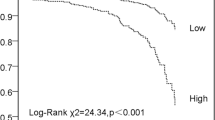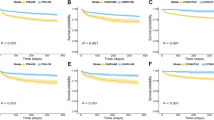Abstract
Objectives
To establish a risk prediction model for in-hospital death in acute stroke patients based on nutritional risk scores.
Methods
A retrospective analysis was performed including 268 acute stroke patients. The Nutritional Risk Screening 2002 (NRS2002) and modified Nutritional Risk in the Critically Ill (mNUTRIC) score were used to evaluate the nutritional status of patients with acute stroke after admission to the neurological intensive care unit (NICU), and laboratory parameters and clinical characteristics were collected. Multivariate logistic regression analysis was performed to screen the risk factors for in-hospital death in acute stroke patients, and a nomogram for predicting death based on the nutritional risk score was established.
Results
The mortality of acute stroke in the NICU was 25.8%. Multivariate logistic regression analysis showed that the mNUTRIC score, female sex, lymphocyte count, pulmonary infection and mechanical ventilation were independent risk factors for in-hospital mortality in acute stroke patients (P < 0.001 or 0.05). The above indexes were used to establish a prediction model of the in-hospital death risk for acute stroke patients. The area under the ROC curve, sensitivity, and specificity of the prediction model were 0.891 (95% CI = 0.853–0.928), 82.5%, and 81.7%, respectively. The nomogram was established and then internally validated using bootstrap repeat sampling 2000 times, the C-index was 0.880, and the predicted values of the calibration curve were in agreement with the measured values.
Conclusion
The mNUTRIC-based nomogram model can be used as a reliable tool to predict the in-hospital mortality risk of acute stroke patients.
This is a preview of subscription content, access via your institution
Access options
Subscribe to this journal
Receive 12 print issues and online access
$259.00 per year
only $21.58 per issue
Buy this article
- Purchase on Springer Link
- Instant access to full article PDF
Prices may be subject to local taxes which are calculated during checkout


Similar content being viewed by others
Data availability
The study datasets is not publicly available to protect patient confidentiality but is available from the authors on reasonable request if needed.
References
Barthels D, Das H. Current advances in ischemic stroke research and therapies. Biochim Biophys Acta Mol Basis Dis. 2020;1866:165260.
Group RospatiCW. Brief report on stroke prevention and treatment in China, 2019. Chin J Cerebrovasc Dis. 2020;17:272–81.
de Jonge JC, Takx RAP, Kauw F, de Jong PA, Dankbaar JW, van der Worp HB. Signs of pulmonary infection on admission chest computed tomography are associated with pneumonia or death in patients with acute stroke. Stroke. 2020;51:1690–95.
Yuan MZ, Li F, Fang Q, Wang W, Peng JJ, Qin DY, et al. Research on the cause of death for severe stroke patients. J Clin Nurs. 2018;27:450–60.
Lew CCH, Yandell R, Fraser RJL, Chua AP, Chong MFF, Miller M. Association between malnutrition and clinical outcomes in the intensive care unit: A systematic review. JPEN J Parenter Enter Nutr. 2017;41:744–58.
Ambrosino N, Clini E. Long-term mechanical ventilation and nutrition. Respir Med. 2004;98:413–20.
Scrutinio D, Lanzillo B, Guida P, Passantino A, Spaccavento S, Battista P. Association between malnutrition and outcomes in patients with severe ischemic stroke undergoing rehabilitation. Arch Phys Med Rehabil. 2020;101:852–60.
Cai ZM, Wu YZ, Chen HM, Feng RQ, Liao CW, Ye SL, et al. Being at risk of malnutrition predicts poor outcomes at 3 months in acute ischemic stroke patients. Eur J Clin Nutr. 2020;74:796–805.
Collaboration. FT. Poor nutritional status on admission predicts poor outcomes after stroke: observational data from the FOOD trial. Stroke. 2003;34:1450–6.
Mukhopadhyay A, Henry J, Ong V, Leong CS, Teh AL, van Dam RM, et al. Association of modified NUTRIC score with 28-day mortality in critically ill patients. Clin Nutr. 2017;36:1143–48.
McClave SA, Taylor BE, Martindale RG, Warren MM, Johnson DR, Braunschweig C, et al. Guidelines for the provision and assessment of nutrition support therapy in the adult critically Ill patient: Society of Critical Care Medicine (SCCM) and American Society for Parenteral and Enteral Nutrition (A.S.P.E.N.). JPEN J Parenter Enter Nutr. 2016;40:159–211.
Machado Dos Reis A, Marchetti J, Forte Dos Santos A, Franzosi OS, Steemburgo T. NUTRIC score: Isolated and combined use with the NRS-2002 to predict hospital mortality in critically Ill patients. JPEN J Parenter Enter Nutr. 2020;44:1250–56.
Morotti A, Poli L, Costa P. Acute Stroke. Semin Neurol. 2019;39:61–72.
Kondrup J. Nutritional-risk scoring systems in the intensive care unit. Curr Opin Clin Nutr Metab Care. 2014;17:177–82.
Reis AMD, Fructhenicht AVG, Moreira LF. NUTRIC score use around the world: a systematic review. Rev Bras Ter Intensiv 2019;31:379–85.
Jeong DH, Hong SB, Lim CM, Koh Y, Seo J, Kim Y, et al. Comparison of Accuracy of NUTRIC and Modified NUTRIC Scores in Predicting 28-Day Mortality in Patients with Sepsis: A Single Center Retrospective Study. Nutrients. 2018;10.
Coruja MK, Cobalchini Y, Wentzel C, Fink JDS. Nutrition risk screening in intensive care units: Agreement between NUTRIC and NRS 2002 tools. Nutr Clin Pract. 2020;35:567–71.
Rattanachaiwong S, Zribi B, Kagan I, Theilla M, Heching M, Singer P. Comparison of nutritional screening and diagnostic tools in diagnosis of severe malnutrition in critically ill patients. Clin Nutr. 2020;39:3419–25.
Marchetti J, Reis AMD, Santos AFD, Franzosi OS, Luft VC, Steemburgo T. High nutritional risk is associated with unfavorable outcomes in patients admitted to an intensive care unit. Rev Bras Ter Intensiv. 2019;31:326–32.
Ozbilgin S, Hanci V, Omur D, Ozbilgin M, Tosun M, Yurtlu S, et al. Morbidity and mortality predictivity of nutritional assessment tools in the postoperative care unit. Medicine.2016;95:5038.
Phan HT, Gall SL, Blizzard CL, Lannin NA, Thrift AG, Anderson CS, et al. Sex Differences in Care and Long-Term Mortality After Stroke: Australian Stroke clinical registry. J Women’s Health (Larchmt). 2019;28:712–20.
Virani SS, Alonso A, Benjamin EJ, Bittencourt MS, Callaway CW, Carson AP, et al. Heart disease and stroke statistics-2020 update: A report from the American Heart Association. Circulation. 2020;141:139–596.
Purroy F, Vena A, Forné C, de Arce AM, Dávalos A, Fuentes B, et al. Age- and sex-specific risk profiles and in-hospital mortality in 13,932 Spanish stroke patients. Cerebrovasc Dis. 2019;47:151–64.
Petrone AB, Eisenman RD, Steele KN, Mosmiller LT, Urhie O, Zdilla MJ. Temporal dynamics of peripheral neutrophil and lymphocytes following acute ischemic stroke. Neurol Sci. 2019;40:1877–85.
Semerano A, Laredo C, Zhao Y, Rudilosso S, Renú A, Llull L, et al. Leukocytes, collateral circulation, and reperfusion in ischemic stroke patients treated with mechanical thrombectomy. Stroke 2019;50:3456–64.
Heuschmann PU, Kolominsky-Rabas PL, Misselwitz B, Hermanek P, Leffmann C, Janzen RW, et al. Predictors of in-hospital mortality and attributable risks of death after ischemic stroke: The German stroke registers study group. Arch Intern Med. 2004;164:1761–8.
Robba C, Bonatti G, Battaglini D, Rocco PRM, Pelosi P. Mechanical ventilation in patients with acute ischaemic stroke: From pathophysiology to clinical practice. Crit Care. 2019;23:388.
Asehnoune K, Roquilly A, Cinotti R. Respiratory management in patients with severe brain injury. Crit Care. 2018;22:76.
Zhao XJ, Li QX, Chang LS, Zhang J, Wang DL, Fan HY, et al. Evaluation of the Application of APACHE II Combined With NIHSS score in the short-term prognosis of acute cerebral hemorrhage patient. Front Neurol. 2019;10:475.
Chen X, Li J, Anderson CS, Lindley RI, Hackett ML, Robinson T, et al. Validation of the simplified modified Rankin scale for stroke trials: Experience from the ENCHANTED alteplase-dose arm. Int J Stroke. 2021;16:222–28.
Heo J, Yoon JG, Park H, Kim YD, Nam HS, Heo JH. Machine learning-based model for prediction of outcomes in acute stroke. Stroke. 2019;50:1263–65.
Acknowledgements
We thank all of the patients in this study for their cooperation: WWZ, YTL, AY. We also thank American Journal Experts (http://www.journalexperts.com/) for their English language editing and proofreading.
Author information
Authors and Affiliations
Contributions
Conceptualization and study design: RXZ and FL. Data acquisition: RXZ and WWZ. Statistical analysis: YTL. Picture editing: AY. Data interpretation: RXZ, LHH, and GWL. Paper preparation: RXZ. All authors have read and approved this version for publication.
Corresponding author
Ethics declarations
Competing interests
The authors declare no competing interests.
Additional information
Publisher’s note Springer Nature remains neutral with regard to jurisdictional claims in published maps and institutional affiliations.
Supplementary information
Rights and permissions
About this article
Cite this article
Zhang, Rx., Zhang, Ww., Luo, Yt. et al. An mNUTRIC-based nomogram for predicting the in-hospital death risk in patients with acute stroke. Eur J Clin Nutr 76, 1464–1469 (2022). https://doi.org/10.1038/s41430-022-01127-0
Received:
Revised:
Accepted:
Published:
Issue Date:
DOI: https://doi.org/10.1038/s41430-022-01127-0



